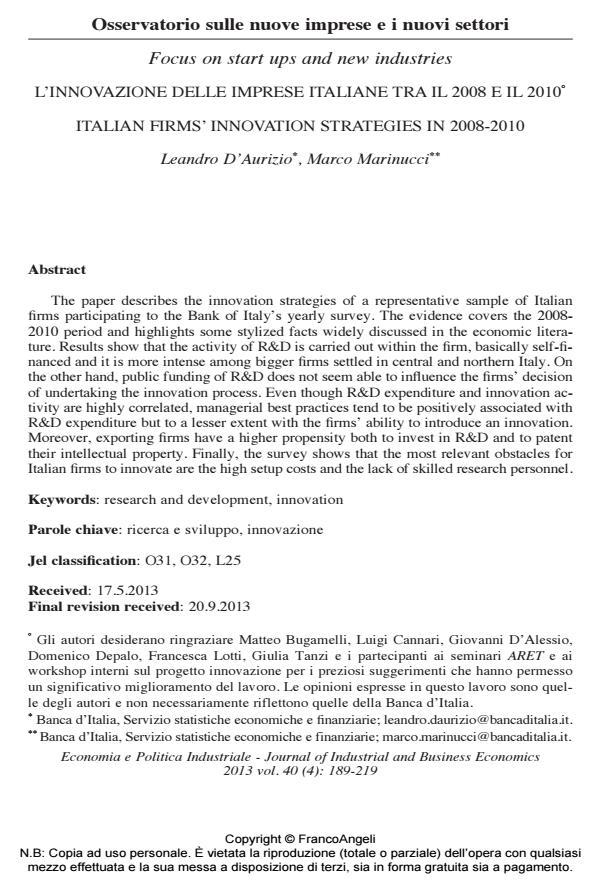L’innovazione delle imprese italiane tra il 2008 e il 2010° italian firms’ innovation strategies in 2008-2010
Titolo Rivista ECONOMIA E POLITICA INDUSTRIALE
Autori/Curatori Leandro D'Aurizio, Marco Marinucci
Anno di pubblicazione 2014 Fascicolo 2013/4
Lingua Inglese Numero pagine 31 P. 189-219 Dimensione file 194 KB
DOI 10.3280/POLI2013-004009
Il DOI è il codice a barre della proprietà intellettuale: per saperne di più
clicca qui
Qui sotto puoi vedere in anteprima la prima pagina di questo articolo.
Se questo articolo ti interessa, lo puoi acquistare (e scaricare in formato pdf) seguendo le facili indicazioni per acquistare il download credit. Acquista Download Credits per scaricare questo Articolo in formato PDF

FrancoAngeli è membro della Publishers International Linking Association, Inc (PILA)associazione indipendente e non profit per facilitare (attraverso i servizi tecnologici implementati da CrossRef.org) l’accesso degli studiosi ai contenuti digitali nelle pubblicazioni professionali e scientifiche
The paper describes the innovation strategies of a representative sample of Italian firms participating to the Bank of Italy’s yearly survey. The evidence covers the 2008- 2010 period and highlights some stylized facts widely discussed in the economic literature. Results show that the activity of R&D is carried out within the firm, basically self-financed and it is more intense among bigger firms settled in central and northern Italy. On the other hand, public funding of R&D does not seem able to influence the firms’ decision of undertaking the innovation process. Even though R&D expenditure and innovation activity are highly correlated, managerial best practices tend to be positively associated with R&D expenditure but to a lesser extent with the firms’ ability to introduce an innovation. Moreover, exporting firms have a higher propensity both to invest in R&D and to patent their intellectual property. Finally, the survey shows that the most relevant obstacles for Italian firms to innovate are the high setup costs and the lack of skilled research personnel.
Parole chiave:Ricerca e sviluppo, innovazione
Jel codes:O31, O32, L25
- Le Caratteristiche Principali DelllInternazionalizzazione Delle Imprese Italiane (The Italian Firmss International Activity) Leandro D'Aurizio, Riccardo Cristadoro, in SSRN Electronic Journal /2015
DOI: 10.2139/ssrn.2600913 - SMEs: Trust and judicial system Marilene Lorizio, Antonia Rosa Gurrieri, in Journal of Governance and Regulation /2016 pp.7
DOI: 10.22495/jgr_v5_i2_p1
Leandro D'Aurizio, Marco Marinucci, L’innovazione delle imprese italiane tra il 2008 e il 2010° italian firms’ innovation strategies in 2008-2010 in "ECONOMIA E POLITICA INDUSTRIALE " 4/2013, pp 189-219, DOI: 10.3280/POLI2013-004009